It all started innocently enough. John Hayes grew up in Michigan and moved to Virginia in the early 80s, marrying his wife, Jan. In 2009, he retired early with the plan to do a little woodworking and play golf four or five times per week.
Read MoreJohn Hayes
Donnie Mays
Ask the folks who know him, and they’ll tell you that Donnie Mays is an expert in clocks. Ask Donnie, though, and you’ll get a glimpse of his characteristic modesty:
“I don’t like being called an expert. I know something about clocks… I don’t put any out that don’t run but I can usually get them to run. Clocks would be a specialty. Rather than be an expert on any one thing, I know a little bit about a lot of things.”
Read MoreOwner of Ruckersville Gallery, Paul Mott has 6 of 50 items featured as most significant in history of the University of Virginia, in a recent article in the U.Va. Magazine. A long-time collector, one of Paul’s specialties is U.Va. and…

This is one of those remarkable moments to own a local yet unrecorded collectible of Charlottesville, Virginia! Wallace Nutting was a well-known photographer and author. When writing his book, Virginia Beautiful, he visited Charlottesville and its environs, taking many images.…

These appear to be rare and early variants of Walker’s Chippendale side chairs or certainly Rappahannock River area. As with other Walker chairs, these have the unique “triple valley” crest rail.” They also have a rarely found C-scroll ribbon back…

All original, this book press is made of iron. There are some old timers who say this was used in securing the newly glued binding, and others who say this was used to flatten warped books. Both explanations seem reasonable.…
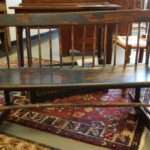
Mammy rockers have long been a well-known furniture form in the South. Iconic in design and use, these uniquely-sized, small, two seaters were used in southern homes throughout the 19th century. Given its deep crest rail and faux-bamboo spindles, this…
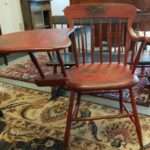
The paint has been restored professionally on this writing arm chair. It was carefully analyzed in the crevices and especially underneath as being red over black, butter milk paint, re-painted, and then worn off appropriately at the major and natural…

This is an exquisite and beautiful Southern Pembroke table. The overall condition is remarkably fine and as found. The primary woods are black walnut and the secondary woods are southern yellow pine. The drawer face has inlaid banding, the apron…

These are both from an old collection of wood relics from historic homes. Both are unique and no others have been seen in over seven decades of my collecting. $750.00 Dealer 326
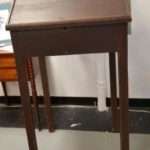
These are most often called a schoolmaster’s desk, but the whole truth would include that they were also used by clerks, pastors, and overseers. This one in particular has great statuesque lines in the Country Hepplewhite form, with what certainly…

Once in a great while is a rived, hand-carved coffer from the Pilgrim century era ever seen. This one was made about 1580 to about 1640, in the Mannerist style, with hard yellow pine and wrought iron. It is a…
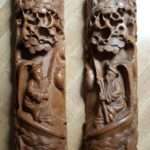
These are mid-20th century, Chinese, carved elm, map or scroll weights. Each is mostly a mirror image of the other, with subtle differences. These are especially useful when unfolding maps for display, holding down the curled edges, but are intended…
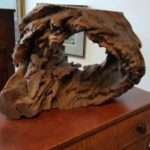
There are a number of fine art traditions found in China, one of which is tree root carving. This carving shows, apparently, a teak tree root or trunk, with enhanced carving of the root interior and the placement of a…

This is a complete original newspaper of the Scientific American, Volume 55, Number 24, published in New York on December 14, 1886. The front page is completely devoted to eight wood block prints of various views of the Miller School…

This is a beautiful, high-style Pembroke Table, made during the Georgian era in the Chippendale taste. Your eye can plainly see the hand-dressed surfaces, the dovetailed drawer, and the lustrous French polished top leaves. The X-stretcher retains its original, underside…

This is an American, miniature, double-drop-leaf table. It is likely rural made, having only straight, instead of rule, joints for both drop leaves. As with most furniture, the turned round legs announce the period and design, namely 19th century Sheraton.…

This chair is attributed to being made by Robert Walker in his cabinet shop in Fredericksburg, Virginia in the late 18th century in the Hepplewhite design. The primary wood is mahogany and the secondary wood is yellow pine. This high-style…

This is a yellow tulip poplar candlestand, with later soldier-blue, buttermilk-based paint. It is light in weight, short in height, and very delicately turned and carved, suggesting that it is likely very early 1700s. It was formerly in the collection…

This is a great magazine rack. Or, for newspaper storage. Or, a place to put pine cones, sea shells, boughs of bittersweet, yarn balls, you name it. $100.00 Dealer 326

A number of other similar candlestands have appeared in the market and in dealer collections, all having the same “feel” of design. For each, the standard is heavy and the legs are high arched. They all are reported as made…

This is an American, probably Mid-Atlantic, Bird-Cage Arm Chair, made about 1800. The faux-bamboo turnings of the stiles, arm rails, and legs became the rage in Windsor chairs by 1800. It certainly seems that all known Windsors were painted, having…
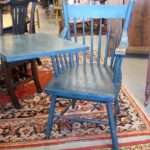
This is a New York chair that was once owned by the former 1821-1823 U. S. Congressman and then the former 1828-1848 Chancellor of New York, Reuben Hyde Walworth, as engraved on the plaque behind the crest rail and seen…

This is an American Queen Anne candlestand. Its specific origin is arguable, but the consensus is American. Because it has a compressed ball column or standard, some have considered that it would appear to be Philadelphia. Its history of ownership,…
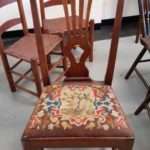
This Chippendale side chair is attributed to Robert Walker (1710-1777) at his cabinet shop in Fredericksburg, Virginia. The primary wood is black walnut, and the secondary wood is yellow pine. The needlepoint seat, which is unlikely original, is nonetheless very…

This is a twentieth-century, bench-made stool. It has turned rock maple and a woven rope seat. It is at the right height to elevate your feet and legs, especially after you place a folded quilt on top, and place near…

This set of six dining chairs was found in the Shenandoah Valley at a sale out in a sunny farm field hosted by hundreds of dealers several decades ago. They are just the way you want to find them, retaining…

This is a galleried country wash stand made of Southern yellow pine. It was from the former collection of Paige McGee, or “Penny” as most of us knew her. She had one of the finest Southern collections ever! It will…

This is an early turn-of-the-century dolly used at the Charles King and Sons, Grocers store at 416 East Water Street in Charlottesville, Virginia. The building was constructed in 1897, and the business continued until about 1980, when it was…

This dressing mirror was made by Meier and Hagen Furniture Makers in New York City between 1858 and 1888. Ernest Hagen (1830-1913) opened a cabinetmaking shop after working for years with others. He had an old shop mate, J. Matthew…
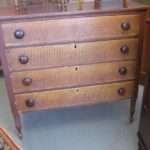
At first glance, this looks like a mahogany case with tiger maple drawer fronts, which speaks well of the maker! This is actually a pine chest with a faux painted case and with faux painted drawer fronts, a rare survivor from…

This is a plain and neat Country Federal corner cupboard from the Valley. It was found, of all places, at the major auction house in the Washington area, C. G. Sloan and Company in Bethesda, Maryland! It had been consigned by…

This clothes press was acquired at a Sheriff’s Sale at a Keswick farm house in Albemarle County in 1986. Then, it had a fresh coat of regular white house paint, some of which can be seen on the back side.…

This is a very practical and useful cupboard, taking a small footprint in anyone’s home. It is also very Southern, made of yellow pine. It was found in the Valley and it was sold in the Valley. Over the years,…

For decades, this side chair was used in my classes through the adult education programs, Open Doors, offered by the Albemarle Public Schools, and the Continuing Studies programs at the University of Virginia. Its use was to show how a…

Decades ago, a good honest country primitive bench seemed easily found. Now not so much. Most seem to be early to mid-20th century. This is a righteous, 19th century bench. Honest wear and use. Actually came off the porch of…

This is a ship captain’s desk, probably coastal New England. As is typical, it is made of New England white pine, with orange varnish over the primary surfaces. From the wear seen, and from the construction noted, it is likely mid to…
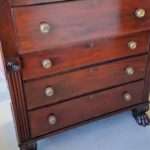
This chest of drawers is a classic example of American Empire case pieces made about 1825. Note the top drawer is very deep for storing bonnets. Unique to this chest is the penciled description on the underside of the second…

This wall cupboard was literally pulled off the wall of the back porch of an old abandoned farm house in Southern Ohio. For collectors of primitive pieces this is just how you want to find them! Old and worn green…
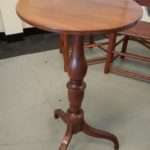
This Southern-attributed, Hepplewhite stand was found at an estate sale in the Shenandoah Valley and then marketed by Irongate Antiques of Occoquan, Virginia in 1981. It is made of mostly cherrywood with some mahogany, hand dressed and hand turned, in…
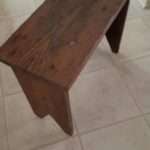
This is a Southern bench, made of Southern Yellow Pine, and found in the Shenandoah Valley. From construction, age, and use, it appears late 19th century to early 20th century. Probably farm made and used. Great for the mud room…

This is an original, 1943, large (56” high by 40” wide) lithograph of the “Freedom From Want” Poster by Norman Rockwell printed by the U. S. Government during World War II. This was acquired in 1980 from a retired Charlottesville…
Paul Mott
Owner of Ruckersville Gallery, Paul Mott has 6 of 50 items featured as most significant in history of the University of Virginia, in a recent article in the U.Va. Magazine.
A long-time collector, one of Paul’s specialties is U.Va. and local Virginia ephemera. In fact, “His assortment of U.Va. items is considered by some collectors to be perhaps the finest that exists outside the University.”
Read More
This American blanket chest appears to retain its original buttermilk paint. Based on the turned feet and the inset panel, it appears consistent with the Country Sheraton era of 1825 and later. Other than normal wear, this chest has no…
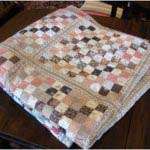
First, this quilt is in wonderful condition. Lacking any puckering or wrinkling, it may never have been laundered. The present consensus of dating is mid to late 19th century. Uniquely, the bottom edge has two cut-out corners, allowing it to…

Though feint, there are stenciled markings on the undersides of the drop leaves, indicating this was made in Winchester, Virginia and “all kinds of furniture.” The stenciling is consistent with a mid-to late 19th century manufacture, part of the well-known…

This is an architectural beauty, given the curved gallery and the scrolled ocean waves sides and the serpentine back! This Country Sheraton wash stand is most likely coastal New England, made of white pine about 1825. $1375.00 Offers Considered, Terms…

Found in and attributed to Greene County, Virginia, this Country Federal wash stand dates to the early to mid-19th century. It is made of Southern yellow pine, and the brass bowl is included with it (although a glazed porcelain bowl…

This is an exquisite clock by a very well-known clockmaker, Benjamin Morris. He was born in Hilltown, Pennsylvania in 1748. He served as a private during the American Revolutionary War. It is reported that during his lifetime, he produced over…

This lavishly carved and well-developed side chair is made from very dense mahogany from the Caribbean rim, probably San Domingo. $2250.00 Offers Considered, Terms Available, Trades Evaluated Dealer 318

This is attributed as an early Queen Anne diminutive dining table or tea table from Edenton, North Carolina. It is made of black walnut and has yellow pine as secondary wood on the underside. The underside angle support is a…

This Southern Chippendale dining chair is very comfortable with its saddled seat. The unique straight crest rail of this side chair is often seen on chairs from eastern Virginia and from northeastern North Carolina during the colonial era. Colonial Williamsburg…
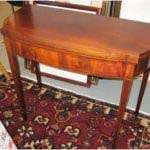
This is a fine, high style Southern gaming table, made of mahogany with inlay. The underside secondary wood is yellow pine. Gaming tables were used by the very wealthy who could afford not only fine furniture made just for gaming…

This chair is attributed to the workshop of Thomas Miller. Born in 1748 in Stirling, Scotland, he migrated to America and was working in Fredericksburg, Virginia by 1765. Unique to his 1770s chair design is the lobed ending at the…
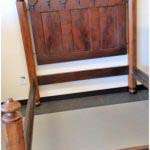
Thomas Day was a free man of color, born 1801 in Dinwiddie County, Virginia. He learned cabinetmaking from his father, John Day. By 1824, Thomas Day had moved to Milton, North Carolina, where he opened his own cabinet shop, working…
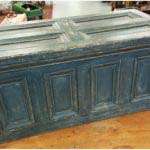
At first glance, this small chest looks much older, like Pilgrim period. It also looks like the paneled furniture of Eastern Virginia. The nails and wear, however, suggest an early 19th century origin. Since the panels are flat, not raised,…

Strtetcher-based tavern tables remain among the most favored pieces of collectors of colonial furniture. This rare surviving Southern table is all made of yellow pine, with a bread-board top over a plain apron supported by Mannerist turned legs in the…

This may be one of a kind. It is attributed as being from the Shake community of South Union, Kentucky. Research at this time reveals that only one kitchen served this small community in the early to mid-19th century. What…

This is a Sheraton sewing work table, made about 1825, with walnut primary and Southern yellow pine secondary. It appears to be entirely in “as found” condition. In its day, it was used primarily as a sewing work table, with…

This handsome walnut chest of drawers was made during the early Federal era from about 1785 to about 1810, in the Hepplewhite taste. Other than the pulls being replaced, the overall condition is as found and pleasingly original. The primary…

This walnut work table came from a sale that had a lot of Kentucky furniture, and this piece too may well be from Kentucky. It is certainly Southern, with Southern yellow pine secondary. Similar tables are reported throughout the country…
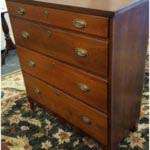
This Federal chest of drawers in the Hepplewhite taste has four distinctively graduated drawers, and a paneled back that is typical of those seen in Virginia, especially the Valley. The primary wood is a favorite of Virginia cabinetmakers, walnut, with…
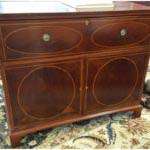
Some of the most beautiful high style Southern furniture is found in Baltimore, such as this unique piece. It is a desk and it is a linen press. The desk is in the top drawer, which pulls out and then…

This all original pie safe appears to be in “as found” condition. While there are no markings found, it appears similar to the “mail order” varieties once so popular in the late 19th and early 20th century sales catalogs of…

This may well be one of the finest model boats ever built. The attention to detail, the exquisite craftmanship, and the precise scale all combine to a magnificent final model. This is a 1930s model boat, handmade from abutted wood…

This 1950s model boat on stand shows lapped wood siding constrruction, brass brads, brass screws, and naugahide. The stand was also custom build for this boat too. You have to wonder what the number of hours this hobbyist project took?…

While Queen Anne herself had a relatively short reign, the furniture named for her had a much longer time, lasting from a little before her reign and then well into the rign of George II. Thus, the era of Baroque…
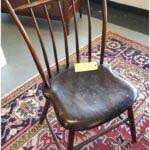
As Windsors go, this one is rather unique. Note the pinched, less than 90°, top corners, where the crest rail joins the side stiles. This is an almost insignificant, but well known, design feature that was used by John Letchworth,…
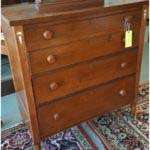
This is a most desirable, folky chest of drawers. It is likely from Southwestern Virginia, but there also are examples from Eastern Tennessee and Eastern Kentucky. The inset side panels and the round turned legs are all suggestive of an…

This is a Victorian era, advertizing display case for scissors and shears. As you can see from the stencil-painted lettering, this one was made by the Cattaraugus Cutlery Company, so named in 1886 in Little Valley, New York. Admiral Byrd…

Based on family history, this candle box is attributed to Winchester, Virginia. As would be expected, it is made of Southern Yellow Pine. T-nails have been used for joinery, suggesting a ca. 1800 time period. Notice the heart cut-out in…

There are various and unique pieces of Southern furniture found virtually no where else. The sugar chest is one of the more iconic pieces first developed in the South. The first one I ever bought was sold to me as…

Your eyes are not deceiving you, that really is a one board top of figured, San Domingo mahogany! The rest of the cleats, block, column, and tripod legs are also solid mahogany. Because everything is mahogany, there are no secondary…

It is unlikely that you will ever again see another early, formal, high style Virginia table like this one. Early country furniture can still be found with some frequency, but certainly not early formal furniture. The simplest explanation is back…

We never met anyone who did not fall in love with this candlestand! It is early, about 1720, delicate, has low height, is deep and mellow in color, shows hand carving and turning, and lightly refinished. There are few people…

Probably the most iconic form of Southern furniture is the hunt board. These do not show up north of the Mason-Dixon Line. They tend to be taller than sideboards, are often made of Southern Yellow Pine, like this one, and,…

This is an American, probably Mid-Atlantic, corner cupboard in the Chippendale taste, having a well-developed cornice, glass doors in the top, raised panel doors in the bottom, all on bracket feet. Having center area drawers suggests an early 19th century…
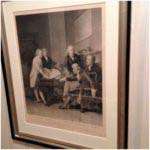
Peter Frederick Rothermel Large period engravings of Thomas Jefferson are rarely seen in the general market, yet the market seems to have an endless array of small engravings, almost all of which were cannibalized from books. In over forty years…
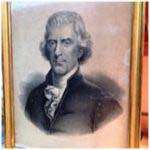
M. H. Traubel Large period engravings of Thomas Jefferson are rarely seen in the general market, yet the market seems to have an endless array of small engravings, almost all of which were cannibalized from books. In over forty years…

Large period engravings of Thomas Jefferson are rarely seen in the general market, yet the market seems to have an endless array of small engravings, almost all of which were cannibalized from books. In over forty years of collecting I…

Kurz and Allison Large period engravings of Thomas Jefferson are rarely seen in the general market, yet the market seems to have an endless array of small engravings, almost all of which were cannibalized from books. In over forty years…

William Smith Large period engravings of Thomas Jefferson are rarely seen in the general market, yet the market seems to have an endless array of small engravings, almost all of which were cannibalized from books. In over forty years of…
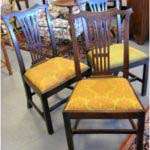
These three matched Chippendale side chairs are attributed to the workshop of Robert Walker, based on the “triple valley” crest rail design. These three matched chairs have primary wood of black walnut and the secondary wood of yellow pine. The…

This is an exceptionally well-designed piece! Compact overall. Graduated drawers. Figured paterae. Delicately turned legs. It is also a piece made for the very wealthy in its day. The household that owned this desk had at least one main servant…
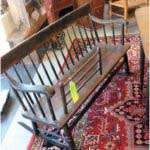
There are a number of furniture designs that are unique to the South. A Mammy Bench is certainly one. It reflects a time now long ago when the South was a slave-based culture and a Mammy would sit in a…

This is the ultimate of pie safes, the most desired, the most sought after, the home run of Southern food safes. From the now classic article in the Magazine Antiques by Roddy Moore, to the acclaim online by Ken Farmer,…
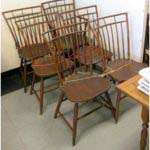
The differences are subtle, slight, and simple. A different curve to the back stiles, or a different profile of a seat, or one with arms are noticeable by staring. All may even have been made in the same shop. They…

Most Southern collectors recognize this table quickly. For a number of years now, there have been quite a few that have surfaced in the trade. The usual story is that they from King and Queen County, Virginia, from about the…

These matched side chairs have remnants of their original red paint. Their design and construction are similar to the chairs of Eastern North Carolina from the mid to late 18th century. At the 2011 exhibit, “Have a Seat,” at the…

This is a Southern Great Chair, probably from the Dan River Basin and, based on the diameter of the legs being equal from the floor to the seat rails, made in the mid to late 18th century (1760 to 1780).…

This black walnut desk is all original, with Country Sheraton turned feet. These more typically Southern desks were so designed that the top could easily be removed to a wagon and taken onto the plantation fields and to the outbuildings…

These are not rare, but they are certainly uncommon. They also are typically Southern. Southern collectors have long come to know the architecture of Southern chairs. The design clue that makes this chair especially Southern is the exaggerated overhang of…

This is an elegantly designed Pembroke table, with delicately carved and fluted legs, rounded drop-leaf corners, and a slender apron. It is one of the few period pieces where the story of its naming has actual roots. Lady Elizabeth (1737-1831),…
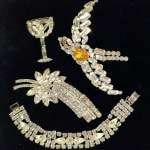
Sandra’s focus is on vintage jewelry, Limoge, cut crystal,vintage jewelry unusual pictures, and vintage linens, but she also carries sterling silver, silverplate, pressed glass, jade, oriental items, mirrors, pictures, and “too many ‘uniques’ to mention.”

Very Unusual – Delightful! Early 19th Century Dutch Dressing Table w Lift Top Storage and Wonderful Detail! (Marquetry) – Booth 314 – $2,475.00. Black Lacquered Screen, Six Sixteen Inch Panels – $875.00, Booth 22. Pair of Oak Desk Chairs –…
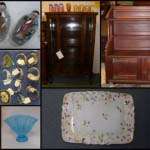
Come join us on Saturday, July 30th for free Appraisals from Norman Dill and Peyton White from 11am until 2pm. Haunting Self Portrait of Rembrandt – Copy in Oil, Late 19th Century, $795.00, Booth 406. Fabulous 21″ Hand Painted Trace…

This weekend on Saturday July 16th from 11am until 2pm we will be having appraisals from one of the top antique appraisers in Virginia and our own Charlie Taylor, resident Crock expert.
Come on down to the Ruckersville Gallery on Saturday, July 9th for this months Estate sale, featuring items such as a collection of 1920’s license plates including Virginia, a 1950’s working traffic light, wonderful new furniture both vintage and modern…

We will be having a casual appraisal event this Saturday July 2nd with Norman Dill and Peyton White from 11am until 2pm, limit 3 items per person, not an appraisal for legal or insurance purposes.
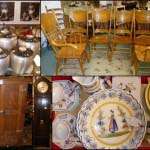
Set of Six Chairs from Booth 75 – Two Arms, Four Side Chairs, $299.00. Antique Ice Box, Beautiful Inside and Out! $1395.00, Booth 75. Fabulous Courting Bench w Magnificent Details, $1299.00, Booth 30. Painted Vanity w Mirror – Seven Drawers…





